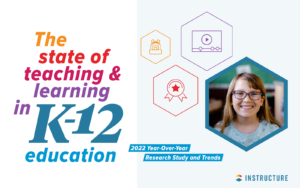Q&A: Teachers Need to be “Provisioned” for Emerging Technologies & Assessment

Dr. Joan M. Mazur, a professor of Instructional Systems Design & Technology in the department of Curriculum & Instruction at the University of Kentucky College of Education, answered a few questions for Getting Smart regarding her recent studies around digital game-based learning (DGBL) following the Serious Play Conference in Redmond, Wash. this August.
Dr. Mazur is interested in the ways that digital game-based learning, emerging technologies and visualization improve curriculum and assessment in education. She is also a faculty associate at the UK Center for Visualization & Virtual Environments and a director of the P-20 Digital Learning & Design Innovation Lab at the College of Education.
In her Q&A, Dr. Mazur talks about the importance of DGBL in developing new learning strategies and assessment models that engage students in learning skills for the 21st century. She articulates, however, that while these new, emerging technologies are widely successful and effective, the current educational system in place prohibits real growth in the games-for-learning industry. She says we need to move away from standardized testing and create new provisions for teaching that welcome and support DGBL in the classroom.
Q. What interested you most about the Serious Play Conference?
A. The Serious Play Conference was a benchmark event, demonstrating the coming of age of the new, available technologies for digital gaming with the best in game design, simulation and performance.
I was impressed by the interests of attendees in what was happening in other fields – the cross-pollination of ideas – what education can learn from business applications, what business can learn from educational applications and so forth…
Q. Tell me a little about the work you have been doing using games for learning in P-20 environments.
A. For the past two years I (along with my colleague Gerry Swan) have been directing the Digital Design & Learning P-20 Innovation Lab at the University of Kentucky. Our focus on DGBL has centered on developing projects that can involve instructors and students from primary through graduate school in the use of game design and integrated curriculum for engaged learning and assessment of 21st Century Skills.
For example, I designed a project called 21st Century GameQuest, which was implemented as an enrichment program for 3rd, 4th and 5th graders at Danville Independent Schools in Danville, KY. Twenty-first Century GameQuesters learned game programming with Scratch and evaluated learning games to eventually help teach in their elementary classrooms. We had graduate-level, pre-service teachers from our college courses (who also learned Scratch) assist with the program. We trained in-service teachers and involved the elementary students – demonstrating that critical thinking, problem solving and collaborative teaming are skills needed throughout the P-20 curriculum, just at varying levels of intensity and skill.
Q. In your personal experience, have you seen results that led to higher performance, skills, knowledge or understanding of new learning through games?
A. Absolutely! In addition to the growing formal research base on digital gaming and learning that builds on decades of research on simulation and performance, all the teachers, students and parents we work with note how immersed students are and how even the most reluctant student shows improvement with DGBL.
Q. What key elements do you believe make gaming effective for learning?
A. My observations are that complex interplay between elements of challenge, strategy, feedback and achieving recognition (in the form of leveling and goal achievement) combined with user control are key.
Q. Why should resources in P-20 schools be spent on technology or digital learning tools like games?
A. Teachers need to be “provisioned” (Jerome Bruner’s term, not mine) for the journey of instruction and assessment for the long haul. Can you imagine a business not investing in what is needed for their employees to do their job? It is not the responsibility of the tools to monitor, support, and train for performance, that is leadership, but having the provisions are essential. Keeping provisions current and fresh also seem like a no-brainer.
Would we provide quills instead of pens? I think it’s also important not to conflate “tools to do work” and tools that “work.” We often ask if “technology improves learning?” The question might be better put: “Does technology assist in the work of teaching and learning?’
Q. What was your biggest challenge during the pilot program that you conducted?
A. Honestly, there were few challenges, except making sure we had the time to plan and train the participant teachers. The district leadership was behind the project all the way, the teachers were committed to learning new things and their students’ learning, and the students and their parents were very enthusiastic about learning about digital gaming for learning.
We reflected as a group quite a bit on the success of the first time 21st Century GameQuest Project. Four elements were essential: (1) Participatory design of all involved, (2) leveraging available resources in tight financial times (3) assessing all along the way and course correcting, and (4) ownership of the project by the school personnel (contributions of all partners and committing to continuing the efforts in later years). We called it the PLAY model.
Q. How does professional development and training for teachers play a role in effectively implementing game-based learning?
A. Teachers are responsible for students’ learning and they need to be ‘provisioned’ with good tools, great training/coaching and support – I see many, many good teachers who are really eager to try new things, but have so many daily pressures that trying new things on their own is really daunting. In order to teach content, teachers need to be fully prepared and also provided with in-classroom/in-school modeling so they feel competent to move forward with the innovation on their own or with peers.
Q. Do you believe that gaming can replace entire curriculums in the classroom or only supplement current learning models that exist?
A. I think the schools in the Quest to Learn study have demonstrated that it is possible, perhaps even desirable to use game design principles to anchor an entire curriculum. As regards “supplementing current learning models,” the biggest inhibitor of meaningful teaching, learning and assessment is high-stakes standardized testing. Until schools are relieved of the burden of having to meet unrealistic goals and benchmarks based on tests unrelated to real world skills, no supplement to any learning models will be successful. Business, industry and health care are light years ahead of education in implementing serious games for learning and performance…
Q. How do you see gaming influencing the way we learn in P-20 education in the future?
A. The biggest influence is understanding two key elements of gaming: (1) the highly immersive nature of gaming worlds effects students learning identities and empowers them in ways that we have yet to understand. We need to leverage that engagement in our more formal environments for learning and (2) that students’ performance in gaming extends beyond the classroom, and we have to be aware of this “other life” that students lead. For example, imagine a student is leading a team of medics to quell an epidemic spreading wildly in a city or developing a strategy to save a city from contagion in a game world then coming into class the next day and having to sit and do worksheets…
A final point on this is that we need to consider in pre-service teacher education that we have an incoming crop of gamer-teachers that also have these out of school experiences…what does this mean for pre-service and in-service programs?
This Q&A was reviewed and edited by Sarah Cargill.






Audrey Brislin
We completely agree with your statement about the importance of providing teachers with the in-classroom modeling to be successful using the tools. We find that to be true across the board when it comes to technologies in the classroom. By providing teachers more than just how to use the software, but actual integration strategies, we can help them and students make the best use out of the technology tools available to them. We appreciate your shared opinions and love to see leaders who see the value in interactive learning tools, like gaming...